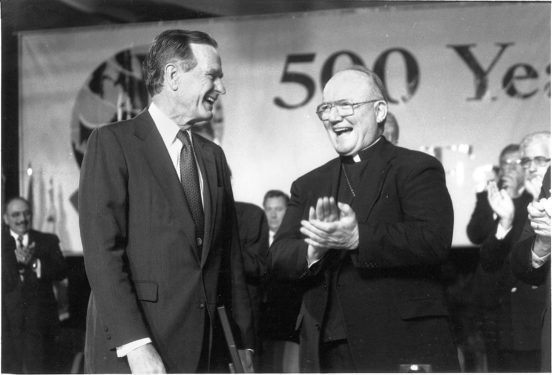By Julie Asher

WASHINGTON (CNS) – When he was running for re-election in 1992, President George H.W. Bush told Catholic News Service that he believed that a strong religious faith could provide “an extra shot of strength when you need it.”
“I don’t believe you can be president without having faith. I really strongly feel that,” Bush said in a telephone interview that October as he flew en route from a campaign appearance in Kentucky to scheduled stops in Florida.
That religious faith which sustained him and his family and was clearly evident during his years in the White House – and more recently as he mourned the April 17 death of his wife of 73 years, Barbara – is being noted by many in paying tribute to his life and legacy after his death late Nov. 30 at age 94 at his home in Houston, Texas.
Spokesman Jim McGrath confirmed the death of the former president in a tweet. The cause of death was not immediately available, but he had been in failing health the last few years. In 2012, he announced that he had vascular Parkinsonism, a condition that limited his mobility and required him to use a wheelchair most of the time.
“Jeb, Neil, Marvin, Doro and I are saddened to announce that after 94 remarkable years, our dear Dad has died,” said former President George W. Bush, the late president’s oldest son.
“George H.W. Bush was a man of the highest character and the best dad a son or daughter could ask for. The entire Bush family is deeply grateful for 41’s life and love, for the compassion of those who have cared and prayed for Dad, and for the condolences of our friends and fellow citizens.”
The White House announced Dec. 1 that a state funeral was being arranged “with all of the accompanying support and honors.” President Donald Trump designated Dec. 5 as a national day of mourning. He and first lady Melania Trump planned to attend the funeral at the National Episcopal Cathedral in Washington. The flags at the White House were lowered to half staff.
Air Force One, technically called “Special Air Mission 41,” flew to Houston to bring the late president’s body back to Washington. After arrival at the Joint Base Andrews just outside Washington Dec. 3, his body was transported to the U.S. Capitol Rotunda to lie in state. The public was invited to pay respects through Dec. 5, when a funeral service was held at the cathedral.
The final “Special Air Mission 41” flight was to return the president’s body to Texas late Dec. 5 for funeral services the next day in College Station, Texas. He was to be laid to rest the afternoon of Dec. 6 at the George H.W. Bush Presidential Library, where wife Barbara and their daughter Robin, who died at age 3, are buried.
Catholic leaders, including the U.S. Conference of Catholic Bishops, joined in “grieving the loss of one of our nation’s leaders.”
“Notre Dame joins with our nation and world in mourning the passing of President Bush,” said Holy Cross Father John I. Jenkins, president of the Catholic university in South Bend, Ind. “He was the epitome of a public servant, not just in the Oval Office, but in his eight years as vice president, his many years as a congressman, ambassador and CIA director, and in his service in the U.S. Navy during World War II.”
“We were fortunate to host him at Notre Dame on five occasions, and in each instance, the honor was ours,” said Father Jenkins said in a Dec. 1 statement. “Our prayers are with the Bush family.”
Bush received an honorary doctor of laws degree from Notre Dame in 1992; he had visited the campus more than any other U.S. president.
The National Right to Life Committee also mourned Bush’s death and praised him for a number of pro-life measures he supported as president. It cited his administration urging the Supreme Court to overturn Roe v. Wade.
